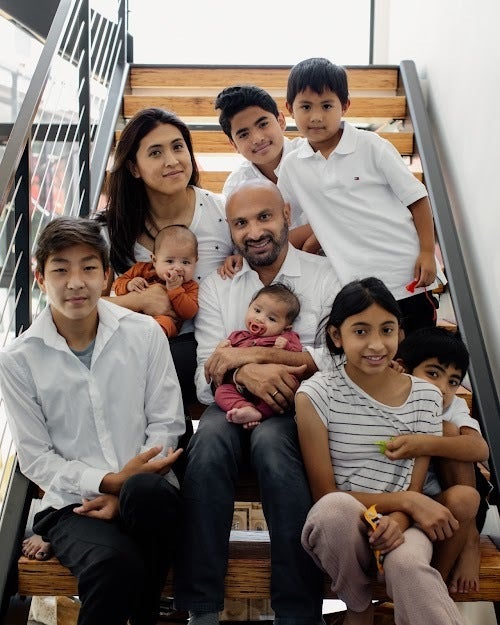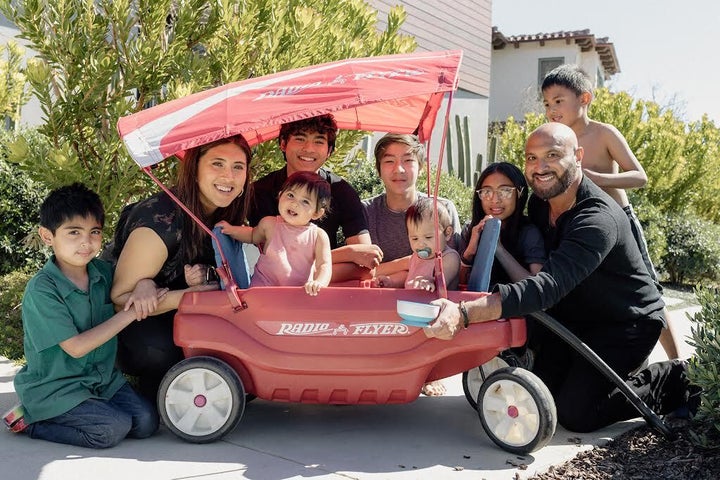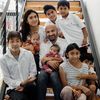
A nurse strolled into the cold, sterile hospital room. She cheerfully introduced herself, then said: “You must be so happy to have made it 40 weeks with twins! How lucky!”
My hands instinctively went to my belly, the palms protecting and supporting me and my babies. A couple of hours away from our scheduled cesarean section, all I could muster was a tired half-smile. My husband, seated next to me, gently squeezed my shoulder, knowing at that moment my mind had pivoted to the twins we had lost during the second trimester many years ago.
Hours later, after the successful delivery of our baby boy and girl, a new nurse came in to help me and asked how I was doing. As I looked at this stranger sheepishly, tears welled up in my eyes. “I’m so glad it’s all over,” I confessed. “I hated every minute of that pregnancy.”
In that moment, I felt the burden of truth lifting from my being. It was a lightness I had not known in years.
My path to parenthood made me one of many statistics. I am one of the 1 in 8 women requiring fertility assistance, and also one of the 1 in 4 women who have experienced a miscarriage or pregnancy loss.
In 2003, a few years into our marriage, my husband and I sought help from a reproductive endocrinologist to create our family due to a previous illness. We were inadvertently thrown into a world that required vulnerability, courage and trust. Begrudgingly, we had to admit: “We can’t do this on our own. We need help.”
We began our fertility treatments naively thinking it would result in a pregnancy without issue. After a few unsuccessful back-to-back IVF cycles, it became clear that we’d gravely underestimated the difficult nature of conceiving via assisted reproductive therapy.
Though I was in my mid-20s, I felt like I was in a race against time. Thus, we continued with IVF cycles for three years, starting new cycles the moment we were given the green light. I never gave my body a chance to rest from the daily hormone injections, egg retrieval surgeries and embryo transfers. During that time there were chemical pregnancies, miscarriages and flat-out failed cycles.
Intertwined with infertility were myriad feelings, from shame and guilt to unmet expectations, isolation and despondency. I underestimated the effect that years of failing to conceive would have on my mental and emotional health.
After three years, we became pregnant with twins. I carried them until 17 weeks without issue. We could finally breathe a sigh of relief. And then one day, out of the blue and for an unknown reason, that light of hope vanished when my water broke unexpectedly. There wasn’t any way to save the pregnancy.
I was so numb from shock that I could barely process what was happening to me. I gave birth to my twins and had to say goodbye immediately. After that, I experienced life through a veil of anguish and despair.
It was during this grief process that we finally had the chance to pause and decide our next steps. Truthfully, I could no longer handle the physical, mental and emotional toll of another IVF cycle. Thus, half a year after the loss of our twins, we pivoted in our approach to parenthood and pursued international adoption.
We realized that families are created in many ways, and we were ready to try a different path to reach our goal of creating our own.
Almost a year after we lost our twins, we became the proud parents of a 10-month-old boy. He was the physical manifestation of our unyielding hope. The veil of sorrow that had become a part of our daily existence finally faded away.
A year of joyful parenthood, however, renewed our sense of optimism, so we decided to try one more IVF cycle at a new fertility center in Denver. We became pregnant with twins again, but this time I carried the pregnancy to term and gave birth to a healthy boy and girl.
A common misconception of pregnancy after ART and/or loss is that the birth of a child washes away the pain experienced from infertility, miscarriage or pregnancy loss. Alas, happy endings cannot erase the effects of trauma. Rather, the happiness just pushes the pain to the back of one’s mind. The immense impact of the trauma of trying to conceive has stayed with me since.
Failing to live up to society’s expectations of “womanhood” resulted in tremendous shame. I struggled with years of degradation that eventually manifested in a fight for control of my body. A few years after the birth of my twins, my untreated mental health issues snowballed into bulimia.
The eating disorder was a cry for help. I lived with this horrible secret for a year unbeknownst to my family and friends. One night, I was putting our 5-year-old and our 3-year-old twins to sleep. I had thrown up the dinner I’d had with them earlier that evening.
As I was tucking them into bed, I caught a glimpse of myself in their mirror, and I didn’t recognize the person looking back at me. After so many years of trying to create my family, I finally had one ― but I couldn’t fully enjoy life because I was so broken inside.
I decided I was tired of living a lie. I confessed my secret to my husband and we found an outpatient facility where I received treatment.
I used my eating disorder recovery as an opportunity to finally begin the necessary work to heal from the damage caused by infertility. During the healing process, I unearthed many truths. Perhaps most profound was the idea that I felt the need to “control” my body through my eating disorder partly because it was uncooperative reproductively. My recovery has continued to teach me lessons on loving myself unconditionally.

As life progressed, every year after the birth of our twins, we received a letter from the storage facility that safeguarded the many embryos from our last IVF procedure. Our embryos were born out of pain and suffering, but they were also created from a tremendous amount of hope. For four years we decided to keep them frozen. On the fifth year, my husband opened up the letter and said to me, “I think it’s time we give these embryos a chance.”
I closed my eyes and tried to visualize myself agreeing to another round of IVF. Could I reopen the wounds of trauma from all the years of failed cycles and the loss of our twins, enduring more physical, mental and emotional pain? Could I risk the ramifications of another pregnancy loss, now that I was a mother to three little children?
I opened my eyes and felt my chest and back tighten. My heart raced and the words got stuck in my throat. After a drawn-out moment, I murmured another truth I had confronted during my healing journey.
“I can’t. I just can’t do it again. I’m so sorry.” As my apology trailed off, my body morphed into a messy convulsion of heaving sobs.
In spite of this honest realization, my husband and I could not ignore the existence of our frozen embryos. We wanted a chance to grow our family.
So we decided to pursue surrogacy. It was a privilege to be able to explore this option. According to the Centers for Disease Control and Prevention, gestational surrogacy accounted for just 1% of all ART cycles in 1999, but that figure rose to 2.5% by 2013. It was an unparalleled journey that was complicated to prepare for and experience.
In addition to asking a medical team to help me have another child, I was now asking a complete stranger to extend a monumental kindness to me and my family.
After finding a surrogacy agency, we waited almost half a year for our turn in the queue to receive and review the dossiers of surrogates. We reviewed many applications and interviewed a few candidates via Zoom. It was daunting to determine the right person to trust to carry our embryos and hopefully become pregnant.
Once we finally matched with a surrogate, legal documents had to be drafted before we could even begin the medical treatments. When we finalized our paperwork, our surrogate had to undergo numerous physical tests to get medical clearance. Once this preliminary clearance was complete, our surrogate was able to go through the protocol for a frozen embryo transfer requiring daily shots and monitoring. At every step of the process, an unthinkable level of trust, vulnerability, collaboration and communication was required.
When we first started our surrogacy journey, I was quick to highlight the physical reasons that led us to pursue this route: unexplained infertility, unexplained loss and an incompetent cervix that required surgery and bed rest in order to maintain a healthy pregnancy.
I never disclosed another important factor in our choice ― the fact that I no longer had the mental and emotional bandwidth to carry a subsequent pregnancy.
Throughout the course of our surrogacy process, I battled my insecurity, shame, jealousy and sadness. In the beginning, the feelings consumed me. However, as the pregnancy progressed and my relationship with our surrogate developed and strengthened, so, too, did my fortitude.
Without complications, our surrogate gave birth to our twin boys. Forever indebted to her, I think of her whenever I look upon my boys’ faces.
A few years ago, after receiving more annual reminders of our remaining embryos, we decided to give our very last set of frozen embryos a chance. In addition to working with a new surrogate, my approach and mindset for this journey were markedly different. I had already confronted the mental hurdles during the last surrogacy process. I now walked into this relationship with more self-compassion and grace.
Like a third of Americans trying to conceive, our path to parenthood was the complete opposite of a textbook experience. As we aspired to become parents, we confronted many challenges necessitating decisions that came with the stigma of choice and the pervasive effects of mental health issues.
Almost two decades after our first IVF cycle, we are now the proud parents of seven children: a 15-year-old son, 13-year-old boy/girl twins, 6-year-old twin boys and 1-year-old twin girls. Our nontraditional paths to parenthood and life as a mother have taught me so many lessons, not least about the power of love and its role in creating families. Although becoming a mom required navigating countless hurdles, it was worth it, every time, to see my children’s smiling faces and experience their joy and wonder.
At first, it was difficult to discuss our decisions to pursue adoption, IVF and surrogacy because most people were unable to comprehend our unique circumstances and thus our actions. With the gift of hindsight and a lot of inner work, however, my perspective changed. I learned to view our choice to ask for help as a sign of our bravery and grit.
Those in the infertility community often refer to themselves and one another as warriors. Some eschew this term, but I feel it to be an apt description of the war that I endured within my mind and body.
For 17 years, I battled against my circumstances and made decisions that caused whispers behind my back. In spite of it all, it took our second surrogacy journey, and finding an online community of fertility advocates, to help me find strength in my story and my voice.
I take pride in speaking up about women’s physical and mental health issues in an effort to destigmatize and normalize these important conversations. As a fertility, pregnancy and parenting mindfulness coach, I often remind my clients that their past does not define them. Rather, your past can serve as a source of inspiration and strength.
Do you have a compelling personal story you’d like to see published on HuffPost? Find out what we’re looking for here and send us a pitch.
